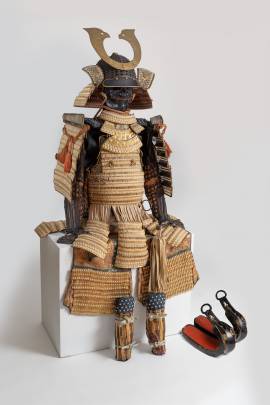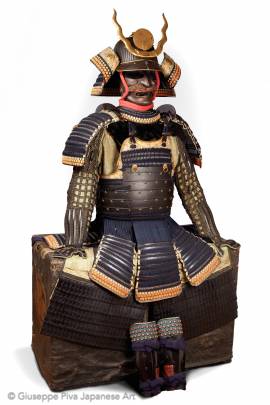Stag antler netsuke representing a Mongol archer 18 Th. century6.6 cm Stag antler netsuke representing the massive figure of a standing Mongolian archer, wearing a full armor under a long-sleeved robe. The archer is shown with his arms stretched along the body while holding a bow in the left hand and an arrow in the right one. The figure is probably a dattanjin, a stranger inhabitant of Dattan and Orankai, the Chinese area where Mongolian and Tartars used to live. Though it was a so common subject, the similitude with the real looks of dattanjin might be...
WORKS FOR SALE
Samurai armor bearing the kamon of the Toyama familyEdo Period, 18th centuryHand-written origami by Prof. Yamagami Hachirō (1902-1980), dated 31 March 1964.Due to its high production cost, golden armor was infrequent during the Edo period. The hon-kozane (true scale) construction for the cuirass, the engraved gilt brass borders, and the haidate (thigh guard) decorated with a floral scroll motif painted with black lacquer over gold all indicate that this suit belonged to a samurai of a wealthy clan. The armor also features a nodowa, an additional protection for neck and throat...
Samurai armor with riveted cuirassJuyo katchū PERIODMid Edo period (1615-1868), 18th centurCERTIFICATE Juyo katchū dated 1989. NKBRK This authentic samurai armor is rated juyo katchū (important armor) by the Nihon Katchū Bugu Rekishi Kenkyukai of Dr. Sasama Yoshiko, author of many books on Japanese armor. The origami is dated 1989.The helmet is a very heavy and high-quality kabuto of suji-bachi type with 62 plates, decorated with gilt-metal borders and fitted with a neck protection (shikoro) with large fukigaeshi...
Copyright © 2016 - giuseppe piva - VAT: 05104180962










